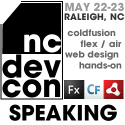ValidateThis 0.99 - Goodies for ColdBox, Debugging and More
Posted At : February 25, 2011 11:33 AM | Posted By : Bob Silverberg
Related Categories: ValidateThis
I promised John Whish that we'd have another version of ValidateThis, an awesome validation framework for ColdFusion, out in time for his presentation at Scotch on the Rocks on March 4th, 2011, and I've never been one to disappoint. So today I announce the release of version 0.99 of ValidateThis.
The lion's share of the work on this release was done by John, Adam Drew and myself. A lot of the work in this release is actually building towards something very cool that will come out later in the year, but there are still some significant enhancements including:
- Goodies for ColdBoxers including a ColdBox interceptor and three new sample applications.
- New debugging features to make it easier to figure out what's going wrong when things aren't working as you expect.
- The ability to ignore a validation client-side.
- Support for onMissingMethod in your objects.
- JavaScript assets are now retrieved from a CDN or written to the browser so you don't need to place JS files in a web accessible folder.
- Updates to the addFailure() method.
- A couple of new validation types were added.
As always, the latest version can be downloaded from the ValidateThis RIAForge site. Details of the enhancements follow:








